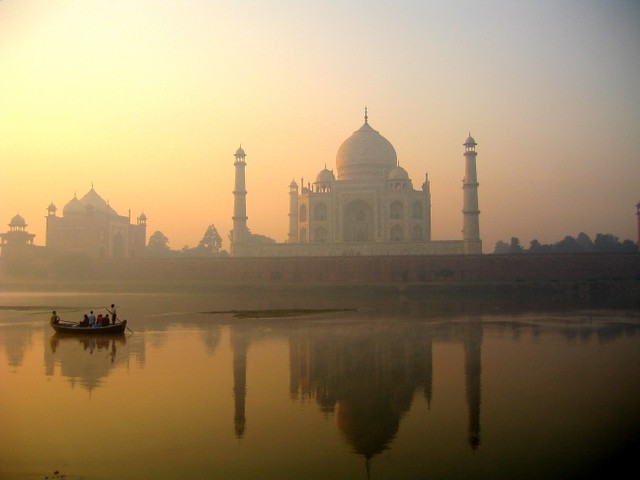The Yamuna River is one of the most beautiful rivers of India. It is the biggest tributary of the Ganges (also known as Ganga) in Northern India. Although the Yamuna River is not navigable, it is of great economic importance to India. There are several canals on the Yamuna that irrigate extensive tracts on both banks. The long, narrow, fertile region between the Yamuna and the Ganges, the Doab, is almost fully irrigated. Besides this, Yamuna also partly supplies the water for big Indian cities like Delhi or Agra.
Must Read : #KnowYourRiver : Krishna River
Religion World will look at the rivers that call for immediate attention, because they have been polluted beyond repair. But the effort is to look at the river, its history, its use and how it was been brought to the state it is now. Our effort to write about these rivers is to enlighten the readers that they need attention and they can once again turn into lifeline for human race in their part. Today we bring, river flowing through Himachal Pradesh, Uttarakhand, Haryana and Uttar Pradesh, Yamuna River.
Yamuna River:
The Yamuna, sometimes called Jamuna is the longest and the second largest tributary river of the Ganges (Ganga) in northern India. Originating from the Yamunotri Glacier at a height of 6,387 metres on the south western slopes of Banderpooch peaks in the uppermost region of the Lower Himalayas in Uttarakhand, it travels a total length of 1,376 kilometers (855 mi) and has a drainage system of 366,223 square kilometres (141,399 sq mi), 40.2% of the entire Ganges Basin, before merging with the Ganges at Triveni Sangam, Allahabad, the site for the Kumbha Mela every twelve years. It is the longest river in India which does not directly flow to the sea.
Must Read : #KnowYourRiver : Godavari River
Origin & Flow
The origin of River Yamuna is at Yamunotri, in the Uttarakhand Himalaya, which lies north of Haridwar in the Himalayan Mountains. The river flows through the states of Delhi, Haryana and Uttar Pradesh, before confluencing with the Ganges at Allahabad. The cities of Baghpat, Delhi, Mathura, Noida, Etawah, Agra, Hamirpur, Allahabad and Kalpi lie on its banks. The major tributaries of this river are the Tons, Chambal, Betwa, and Ken; with the Tons being the largest. Yamunotri is the source of the Yamuna River and the seat of the Goddess Yamuna. This spot is considered as one of the four sites in India’s Char Dham pilgrimage.
Tributaries
Betwa River: Betwa or Vetravati originates in Vindhya Range just north of Hoshangabad in Madhya Pradesh and flows north-east through Madhya Pradesh and flow through Orchha to Uttar Pradesh. It meets Yamuna at Hamirpur town in Uttar Pradesh.
Sindh River: Sindh River originates on the Malwa Plateau in Vidisha district, and flows north-northeast through the districts of Guna, Ashoknagar, Shivpuri, Datia, Gwalior and Bhind in Madhya Pradesh to join the Yamuna River in Etawah district, Uttar Pradesh. Manikheda Dam has been constructed across the Sindh River in Shivpuri district, Madhya Pradesh.
Hindon River: Hindo River is a rainfed river that originates in the Saharanpur District. It flows between Ganges and Yamuna rivers and joins Yamuna river just outside Delhi.
Chambal River: Chambal River is one of the most pollution free rivers of India. It’s a 960 Kilometer long river that originates at the Singar Chouri peak in the northern slopes of the Vindhyan mountains, 15 km West-South-West of Mhow in Indore District in Madhya Pradesh. It enters U.P. and flows for about 32 km before joining the Yamuna River in Etawah District at an elevation of 122 m, to form a part of the greater Gangetic drainage system. Chambal is a rainfed river and its basin is bounded by the Vindhyan mountain ranges and on the north-west by the Aravallis.
Legend
Yamuna is next only to the Ganga in her sacredness. According to legend, Yamuna was a great favourite of her father Surya, the Sun god. Her mother Sanjna could not bear to look at her bright and dazzling husband. As she looked upon him with “samyama” (meaning restraint in Sanskrit) their son was called Yama. In spite of Surya asking her to keep her eyes open in his presence, they sometimes flickered, and so the daughter was called Yamuna.

In various old temples of Northern India, Yamuna is shown on her tortoise, a symbol associated with creation in the Vedas. Even today, tortoises can be found on the banks of the Yamuna.
After the children were born, Sanjna left her sister Chaaya (shadow) in her place pretending to be her, and returned to her parents’ home, as she could not bear the Sun’s intense brightness. Once Chaaya bore children, she was not very compassionate towards Sanjna’s children. One day, Yama, unable to tolerate Chaya’s cruelty any longer, stamped her foot hard. Enraged by this, Chaya cursed that that he would lose his foot. Yamuna his beloved sister could not bear this injustice. She came to Earth and prayed for the curse to be revoked.
Must Read : Science of Compassion” – A Documentary on Amma, Sri Mata Amritanandamayi Devi
In memory of this profound love between brother and sister, bhai dooj is celebrated in various parts of the country. Sisters pray for their brothers to have a long life and brothers vow to look after and protect their sisters. This is when the “rakhi” is tied.
Lord Krishna’s Yamuna
The Yamuna also known as Kalindi is an essential ingredient of Krishna lore. This river is a recurring image in all stories of Krishna: she watched his father carry him across the river to Gokul, she watched him herd cows and fight demons in the pastures of Vrindavan, she was witness to the clandestine meetings between Krishna and Radha, she kept careful watch so that no one interrupted the Maha-Raas. She saw the milkmaids weep as he left for Mathura, pining for his return. She saw him fight the hordes of Jarasandha who burnt down the city of Mathura with the help of the Indo-Greek mercenary, Kalyavana. She saw his flight to Dwarka and his triumphant return in the company of the Pandavas and their common wife, Draupadi. She saw him organize the burning of the Khandava forest and the building of the magnificent city of Indraprastha. She heard Krishna’s discourse to Arjuna and his conch shell trumpet as he rode into the battlefield of Kurukshetra intent on bathing the earth, and her waters, with the blood of unworthy kings.

According to devdutt.com: “Krishna’s brother Balarama, who was paying a visit to the area long after Krishna had moved to Dwarka, felt like bathing in the river. But he was too drunk and too tired to walk to the river. He ordered Yamuna to come to her. She refused. Enraged, Balarama, raised his plough and dragged the river-goddess towards him. Khushwant Singh, in his book Delhi narrates the folk version according to which Balarama dragged Yamuna by the hair and had his way with her. Her struggles gave rise to the many bends of the river around Delhi. The story according to some anthropologists is suggestive of canal irrigation by the Surasena tribe. Balarama with his plough was their god of agriculture while Krishna with his cows was their god of animal husbandry; together they were the gods of the primary economic activities of a civilization that according to archaeologists thrived as early as 600 BC.
“After being dragged to Indraprastha, Yamuna begged Krishna to make her his wife. Without him, no one cared for her. Nobody respected her. As Kalindi, she became one of Krishna’s eight principal wives. But he left her to flow in Vraj while he ruled far away in the island city of Dwarka. Still she waits for him. Hoping that Dwarka-pati, the Mathura-Nagar-Pati, will come back to Gokul. She hopes for the magic of the moonlight. The romance of the flute. The secret dance of Radha and the milkmaids. It is said that no man may join this dance. Shiva wanted to join it. Arjuna wanted to join it. Yamuna asked them to bathe in her, shed their masculinity, become women and dance with Krishna accepting them, as she did, as their supreme lord.”
Taj Mahal on Banks of Yamuna
The Taj Mahal and most of the thriving city is located on the west bank of the river which played an important role in the development and construction of the Taj Mahal, and provides a dramatic backdrop. The site was chosen downstream from Agra Fort and past a sharp bend. The calm water provided a mirror and the shimmering reflections give the feeling of a ‘floating tomb’, an idea accentuated by the water channels in the gardens.
The water which fills the channels was once fed from the river and historical evidence suggests it was physically moved to flow closer to the building. This enabled sand and shingle from the river-bed to be used in construction.
Boats were a popular mode of transport and the water ways would have been much busier than they are today especially as the Yamuna links Agra to Delhi. Construction materials and workers arrived by boat, as did many visitors and the peaceful body of Mumtaz Mahal.
After his death, Shah Jahan’s body was also taken to the Taj Mahal down the river before being laid to rest next to his beloved wife.
The other side of the story is the pollution of Yamuna River is directly affecting Taj Mahal and is putting the world’s greatest monument into danger. Though measures are being taken up to save Taj Mahal and cleanse Yamuna, all those seem to be not sufficient enough.
Must Read : #KnowYourRiver : Kaveri River
Spiritual Connect
The Yamuna is a sacred river for Hindi. Yama is the Goddess of the Yamuna River, the sister of Yama, god of death. Also, on the night of Krishna’s birth, it is said he crossed the Yamuna River, which parted to make place for him to cross the turbulent waters. Yamunotri temple, a shrine dedicated to the goddess, Yamuna is one of the most prominent shrines in Hinduism, representing the Chota Char Dham Yatra circuit.

The Yamunotri Temple is situated near a hot spring running water in geyser force and in which the pilgrims cook their food. The Temple of Yamunotri is at the foothill of the Kalind Parvat at the left bank of the Yamuna at a height of 3,185 metres. Acting as a backdrop, a glorious waterfall drops, more than 2,000 metres from the snow of Banderpoonch into the valley at this point. Besides ‘Ratnjot’ an herb claimed to be curative for eye diseases, with chestnuts, walnuts, and apricots grow in abundance in this valley. A frozen lake of ice on the top of Kalind Parvat, at a height of 4,421 metres and almost a kilometre further up is the source of the Yamuna but since the approach to it, is extremely unsafe, the temple has been built at the foothill. Here, the sage Asset had his habitat, all his life he bathed in both, Ganga and Yamuna.
Ecological issues
With over 50 million people dependent on the water of the Yamuna along with rapid population growth, the Yumuna has developed into one of the most polluted rivers in the world. New Delhi, the capital of India, dumps much of its waste into the river, generating almost 2 million liters per day of sewage. Another issue is that the water remains stagnant for almost 9 months a year, leaving the sewage to rot leaving a thick white foam that covers much of the river around New Delhi. India has spent almost $500 million in cleanup efforts but the Yamuna River continues to be polluted at a huge scale due the magnitude at which pollutants enter the Yamuna on a regular basis.









